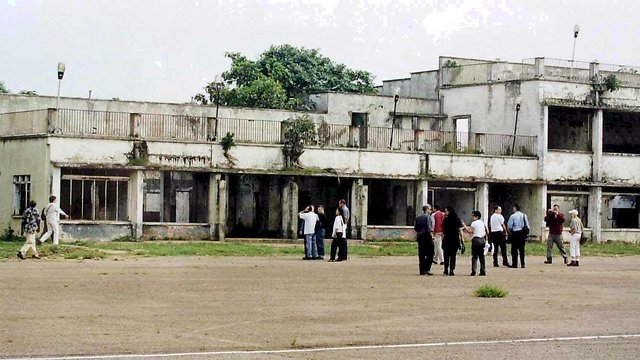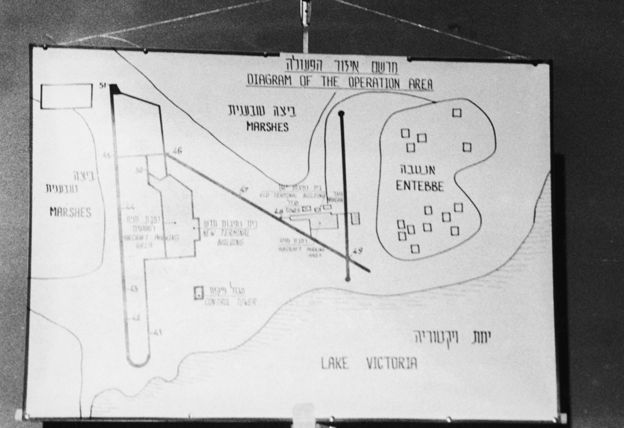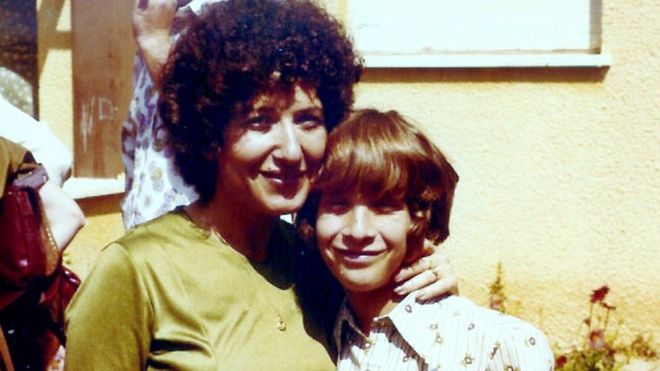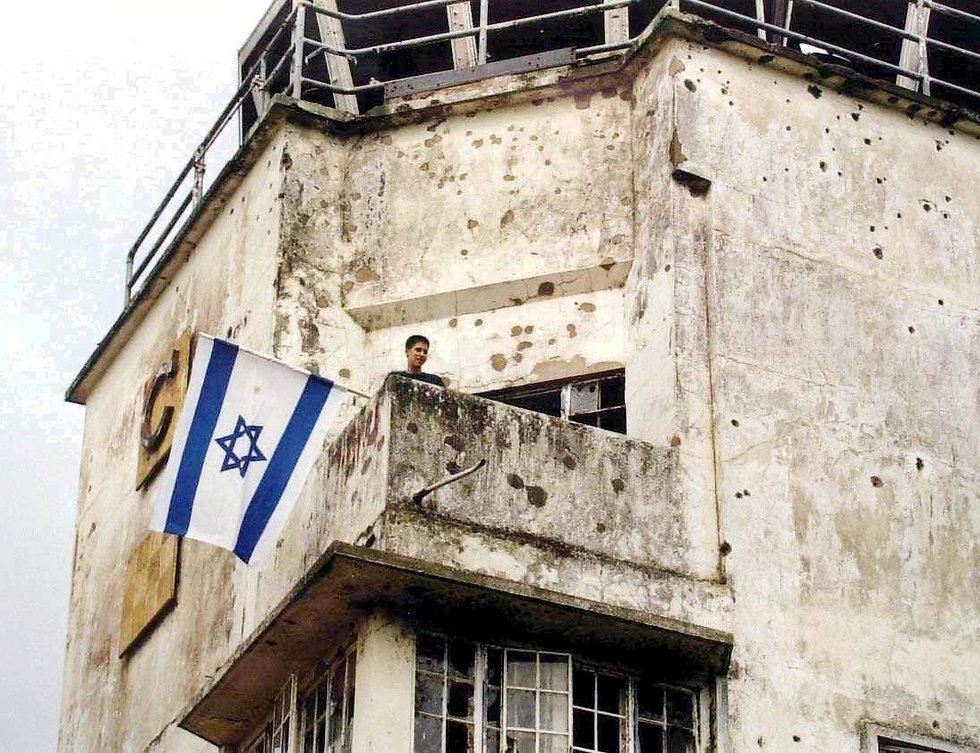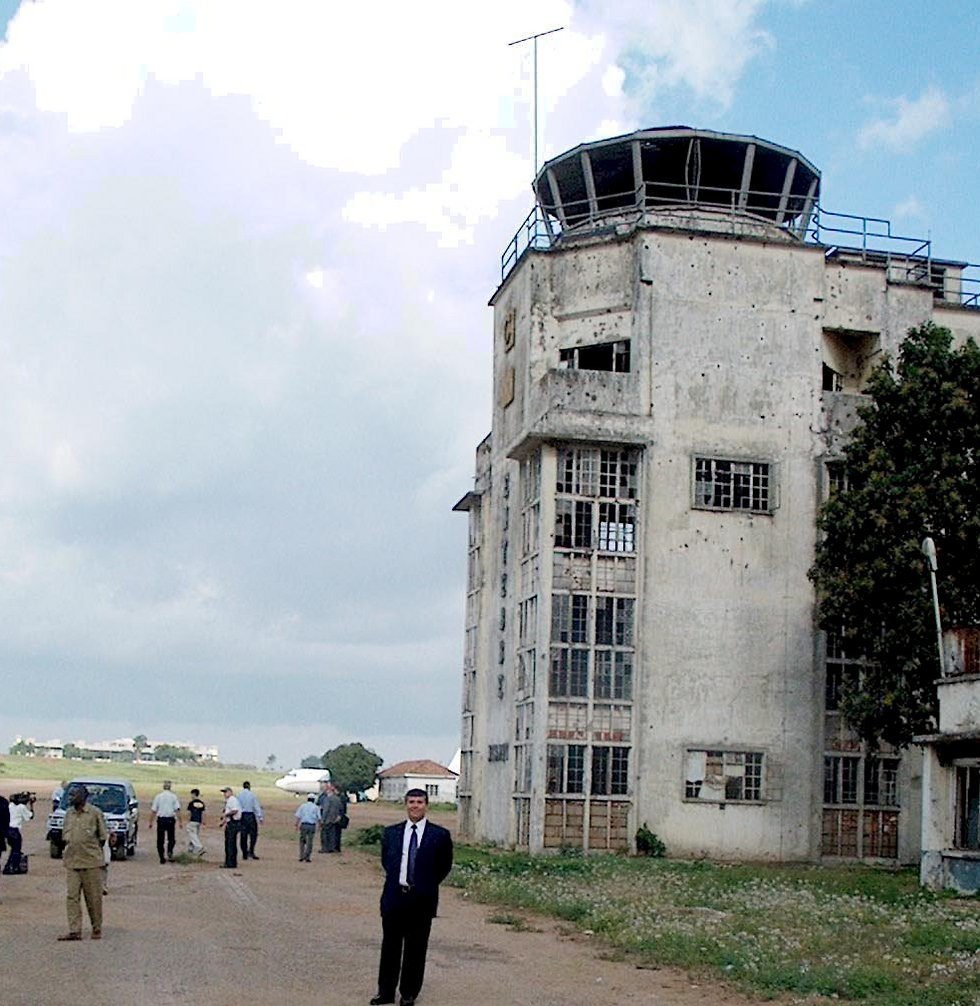
Operation Entebbe as told by the commandos: Storming the terminal
40 years after one the most famous commando operations in history, Sayeret Matkal's soldiers recount the events that culminated in the release of 106 hostages from an airport terminal in Uganda: Entering the terminal alone, fighting in the dark corridors and Yoni Netanyahu's injury. Part 3 of 5.
"We started walking quickly towards the terminal building," says Shlomi Reisman, a first sergeant. "In the briefing, Yoni stressed that we shouldn't run so that we wouldn't tip off the guards that were supposed to be posted outside the terminal. We walked together, a tight group of some 20 commandos nearing the entrance to the terminal that was a couple of dozens of meters ahead. And yet, it was still strangely quiet all around us.
"Muki (Betzer, one of the team leaders —ed.) led the force, as planned. I stayed close to his right. Yoni gave him the job considered most crucial in hostage situations: being the officer who charges first into the hall where the hostages were being kept, through the first entrance. Amnon's team, which I was a part of, was meant to go in through the second entrance, a bit farther away.
"Around us, it was completely silent. But that silence was broken by a short burst of gunfire. A Ugandan soldier suddenly appeared to our left, in the space between the control tower and the terminal, and before he could realize what was happening, he was shot—I believe by Muki. And still, we didn't hear any sounds of gunfire from inside the terminal, and no one was shooting at us.
"We kept moving, walking faster. We already walked past the control tower, which was looming over us to the left. In front of us, we saw the big structure of the terminal. Out front were large crates scattered around. The walls and the plaza outside were faintly lit by yellow flashlights. We were now only several steps away from the terminal building: the most critical stage of the operation. All we had to do was storm it, get to the hostages quickly, and hit the terrorists before they would have a chance to pick up their weapons."
At this point, another incident occurred, which to this day is a point of contention among the commandos.
"At the corner of the building, Muki stopped, fired a few bullets at a figure that appeared down the hall, and got held up changing his magazine. Yoni, who was running in the open area parallel to us, called out, 'Betzer, come on!' The holdup was unnecessary and unclear. We were standing behind Muki and waiting for him to finish changing his magazine," says Alex Davidi, a staff sergeant in Muki's team.
Yiftach Reicher-Atir, the deputy Sayeret Matkal commander who also led his own team, remembers, "I was moving quickly with Muki and Yoni towards the building. Near the entrance, Muki stopped and started shooting into the building. I didn't see any target, and Yoni yelled to Muki that he should continue advancing and even made a step towards the building, as if he was going to go past Muki. I went past Muki myself and entered the room I was assigned to raid."
Betzer himself explains, "I saw a terrorist—ostensibly a German one—coming outside, looking at us, crouching and preparing to open fire at us. I fired the second half of my magazine at him and didn't hit him. He jumped back into the passengers’ hall. I stopped for a second to change my magazine. I didn't announce that I was changing my magazine (as is standard in such operations —ed.), because I wanted to lead."
Amir Ofer led the troops instead. "Officers and soldiers immediately got past Muki, who was standing still, and continued on their missions without waiting for him to keep leading. Seconds later, I saw Yoni fall and someone yelled, 'Yoni was hit.' I saw all of this through the corner of my eye, and it happened a few dozen meters away from me while I was running as fast as I could to reach the building."
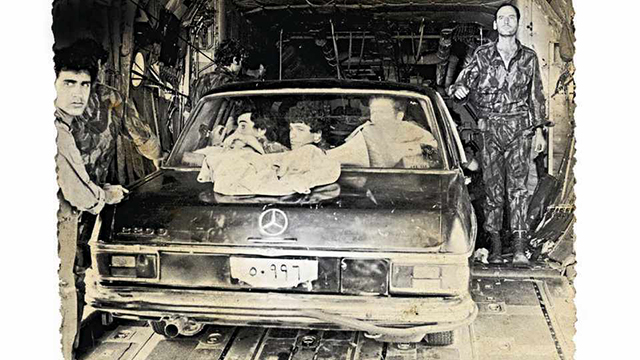
Tamir Pardo, the former director of the Mossad, was Netanyahu's radio operation during the operation. "As we were running, I stayed close to Yoni. We came under fire from the tower, and if memory serves me right a Ugandan soldier who was by the terminal also opened fire (at us). Yoni was hit... he was so close I could reach out and touch him. His body did half a turn and then he fell... I remember myself saying on the comms 'Yoni was hit.' David (Hassin) the doctor came up to him and I joined Zussman's team," Pardo recounts.
"On my way, I fired towards that soldier, who at the moment I believed was the one who shot Yoni. Bullets that were fired from the tower hit the asphalt and pieces of it popped up and scratched my hand," he adds.
Amir Ofer was the first commando to enter the terminal. “When I was 10–15 meters away from the building, I saw the glass wall shatter, and a long burst of gunfire was shot directly at me by a terrorist who was lying down right in front of the door, about five meters into the building. The bullets flew past me on the left and right, but luckily missed. I was counting the bullets left in the terrorist's magazine—he fired 17 bullets. I returned fire, and we shot at each other at the same time, while he remained lying (on the ground). I shot four bullets at him in quick succession through the glass wall. Two of the bullets were tracer bullets, and I could see them connecting, his head slumping, and his gunfire stopped.

"I went inside, made two or three steps, and shot him again at close range. I looked to the right and saw that none of our troops were inside the room, so I realized I was first in the terminal and immediately realized I was in far graver danger. I was completely alone inside a massive hall into which eight soldiers were supposed to storm at the same time from two different entrances, and in which over 100 hostages were, with some of the terrorists among them. It was likely these terrorists were already aiming their weapons at me from several locations in the big hall. It was clear to me that I couldn't stay where I was for even a fraction of a second longer, because in a moment a burst of gunfire would be aimed at that spot. I leapt backwards and pressed up against the wall, while ducking and looking left to the other side of the hall where, I assumed, there were other terrorists.
“During that time, several meters behind me, a real drama was unfolding. Amnon was several meters behind me and running as fast as he could to catch up to me."
"I went inside right after him and saw two terrorists, a man and a woman, with their weapons aimed at Amir's back," says Amnon Peled, a captain who led the Amnon Team. "I fired two bullets into each of them and kicked their Kalashnikovs away. It later turned out they were the Germans. Amir was yelling into a megaphone in Hebrew and English, 'Everyone on the ground; we're here to take you home.' Several more seconds passed in which Amir and I were alone in the big hall. And then Amos Goren, Gadi Ilan and Muki Betzer came. I didn't know why they came in through our entrance and not their own."
This, too, is a point of contention among the commandos. "I stopped next to where my entrance was supposed to be, but couldn't find an entrance. It just didn't exist," Betzer explains.
"I scanned the room, back and forth, and all of a sudden I saw on my left, next to a pillar, a figure rising quickly," says Amos Goren. "I realized it was one of the terrorists who was raising his Kalashnikov to shoot. I fired two bullets at him. The first hit his weapon, which was raised chest-high, and sent it flying out of his hands. The second bullet hit him directly in the chest. He was the last terrorist who was in the room the hostages were kept in. Even if there were explosives, there was no one left to set them off.
"I looked at the hostages, and they were all in shock. They were lying on mattresses, parents holding tightly onto their children, protecting them with their own bodies. Amir and I walked around them with a megaphone. 'We're soldiers from Israel,' we told them—Amir in Hebrew and I in English, 'We've come to take you home.' They looked at us with shock. Only a few moments ago, they were in a different world, in hell, not knowing what was going to happen, whether they are going to live in an hour or be executed. They certainly could not imagine that there was a chance that the IDF would come and rescue them. And now, it was as if a hand from the heavens was sent for them and plucked them from one world into another.
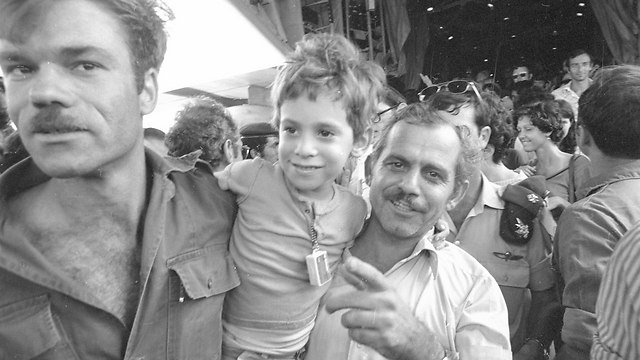
"Several of the hostages got to their feet, some stayed lying down. I walked up to a woman protecting her young son with her body and told her, 'It's okay; we're here to take you back home.' She looked at me with a stunned expression and nodded: 'Yes, yes.'
"Two years ago, the Mossad organized an exhibition on the Entebbe Operation, and several of the commandos and hostages were invited. One of the hostages, Sara Guter Davidson (who also wrote a book about her experience —ed.), talked about the events that had occurred and what the hostages were feeling inside the terminal, and about the moment the Israeli forces charged inside. She was talking about how she was lying over her son to protect him from the gunfire, and when she raised her head she saw 'a lovely Yemenite officer with a white hat and leopard uniform' standing over her and speaking Hebrew. When she was done talking, I walked up to her. 'I'm that lovely Yemenite,' I told her. 'Even thought I wasn't an officer, and I'm not really Yemenite...'"
Radio operator Tamir Pardo tells that clearing the passengers' hall of terrorists didn't take a long time. "If memory serves me, we had the hostages under our control within less than ten minutes, and we started getting ready to evacuate them. An hour after we landed, we were on the last plane leaving Entebbe."
Fighting through the terminal’s corridors
During those very moments, the other Sayeret Matkal teams were operating across the terminal building. Yiftach Reicher-Atir was commanding two teams whose job was to clear the customs hall and the second floor, which served as living quarters for the Ugandan soldiers. He says he and his men killed about 11 Ugandan soldiers, while "not a single shot was fired at us," and that "there were signs that indicated there were at least 60 people there who were able to get away."
"While we were entering the terminal and going upstairs, we encountered a few Ugandan soldiers running towards us—probably in an attempt to escape the building—and we shot them," says Rani Cohen. "We started making our way back to search the cafeteria and the corridor. At this point, all the lights were off, and we were operating with our rifles' flashlight mounts. All of a sudden, I saw a Ugandan soldier coming at me. I shot him, heard glass shatter, and he disappeared. It was a mirror."
Map in Hebrew of the old terminal with markings indicating which force was to go where (click for full size)
Pinchas Bucris and Arnon Epstein were part of Reicher-Atir's team. "When I jumped off the Land Rover, my MAG (FN MAG 58 machine gun) strap got stuck on the seat," Buchris remembers. "It was a few seconds before I was able to pull it off, and then I found myself alone. I was trying to run but my feet wouldn't budge. I told myself, 'Buchris, run,' and then I started running; I felt like I was running on marbles, probably out of fear.
"I went into the first section of rooms in the terminal. While I was walking inside, I saw a few soldiers in leopard uniforms lying on the floor in the middle of the room. The thought crossed my mind that these might be our guys. When I came closer, I saw the color of their skin and their curly hair, and I calmed down. I kept going and met the rest of the team while it was on its way back from the end of the first section of rooms."
Later, Buchris says, while fighting, "I felt someone or something touching my shoulder and mumbling in a language I didn't understand. At first, I thought it was someone from my team, but when I turned around, I saw a massive Ugandan soldier standing over me, with the barrel of his weapon touching my neck. I quickly realized it would be hard to shoot him with my MAG. I yelled to Arnon, 'There's someone over me; shoot him.' And indeed he shot him over my head and killed him. At that moment, I realized the leopard uniforms must have saved me. He thought I was another Ugandan soldier. That incident led me later to dwell a lot on what would've happened if things had gone differently."

Another team of Sayeret commandos was led by Giora Zussman. Their job was to break into the smaller hall in the terminal, where they thought some terrorists, and maybe some hostages, might be.
"I got to the entrance first," Zussman says. "I came in and fired at a bed used by terrorists who were off guard duty, and for a moment I thought someone was lying there. I found a corridor to my right that we didn't know existed and fired into it. Two people came out of the last room with their hands up. It was very clear to me they were terrorists, and since we knew the terrorists might be wearing an explosive belt, I gave Shlomi (Reisman) an order to shoot them."
Shlomi Reisman recounts, "They went past Zussman and marched one after the other towards me. The one in the back looked like a woman. As they were walking past him down the corridor, Zussman shouted 'Reisman, shoot them, shoot them!' He couldn't shoot them without hitting me. The two kept walking towards me at a fast pace, their hands to the side of their body—as if they've yet to decide whether they wanted to surrender or not. I moved aside and let them get past me. Despite Giora's order, I hesitated and didn't open fire. I wasn't convinced they were terrorists. What if they were scared hostages?
"I ordered them to stop in Hebrew, English, and Arabic. They completely ignored both my calls and the fact the barrel of my weapon was aimed at them, and kept walking towards the exit, trying to escape into the darkness. It was only at this point that I noticed the first terrorist was holding a grenade. Because of the problematic line of fire and the concern I would hurt my friends, I quickly got closer and shot them both, one through the other. My burst of fire glued them to one another and they both collapsed to the floor together.
"I saw a bluish spark under the bodies, and knew immediately what it was. I yelled, 'Grenade!' except there wasn't exactly anywhere to hide. I pulled Tamir (Pardo), who was standing next to me, into an alcove in the wall. Luckily the grenade went off under the terrorists. To this day, every dentist asks me what's the small lump of metal stuck in my face that shows up in x-rays."
Among Zussman's team were also Adam Coleman, Amnon Ben-Ami and Yoram Rubin. "Zussman sent us to the entrance that was farther away, and turned to the one on the right," Coleman says. "I got to the corner, glanced ahead, and saw a barrel of a gun peaking from the end of the 15-meter-long corridor. I started throwing grenades towards the passage, where the gun barrel was, and advanced with Amnon covering me from the back. When I got close to the end of the corridor, I saw it was leading towards a big hall filled with boxes and other cargo. I threw another grenade inside, towards the gun barrel I saw, and then went around the corner and, at close range, shot a soldier who was lying down in a shooting position behind cover with his weapon aimed forward. It looked like he had already been wounded by the grenades.
"We went back to the corridor, and I saw another Ugandan soldier coming from somewhere at the other end of the hall, advancing towards me and taking cover between the boxes. I called out to Amnon and Yoram, telling them there was another soldier and that they needed to keep covering me. The space was very large, and there were a lot of boxes. It looked like a dangerous place to wander around—it could’ve contained a lot of surprises. I threw another grenade or two in his direction and then ran out. I had a phosphorus grenade left on me. I decided I wasn't going to leave that soldier there, not knowing if he was dead or alive. I threw the phosphorus grenade, which caused sparks and white smoke, and used that as cover to charge—in between the boxes—towards the soldier. I shot him at close range, made sure he was dead, and then got out of there back towards the corridor and the entrance hall. On my way, I reported to Amnon about the two dead Ugandan soldiers. I was in an unstoppable frenzy.
"I remember being rebuked by Muki for throwing a phosphorus grenade inside a closed space, because a fire could have broken out and then we wouldn't have been able to see what was going on. As far as I was concerned, at that moment I acted with the best means at my disposal. But I can't let go of the memory of that rebuke."
'Yoni was hit!'
In the main passengers’ hall, the hostages were starting to realize their lives had been saved.
Betzer says, "One of the hostages carefully got up and slowly walked towards me. I didn't have ranks on, but from the orders I was giving, he understood I was the commander, and told me in a calm voice: 'You killed all the terrorists here. All of the others are in the next room,' indicating at the VIP lounge on the other side of the wall. That very second, Giora Zussman announced over the comms: 'Mission accomplished. Muki, mission accomplished.'
"The entire drama lasted less than a minute. I called Yoni on the comms and told him, 'Yoni, this is Muki, the mission has been accomplished.' There was no answer. I tried again and again—but all I got was silence. During my third attempt, Tamir (Pardo), the radio operator, came on the comms: 'Muki, Muki, Yoni was hit! Yoni was hit!' I told Amnon Peled to treat the injured among the hostages and rushed outside.
"Next to the terminal wall, I saw Yoni, my friend, lying on his back. Dr. David Hassin was kneeling next to him, ripped his shirt open and started treating him. Unfortunately, I was already used to seeing wounded people and Yoni, at that moment, seemed fatally wounded.
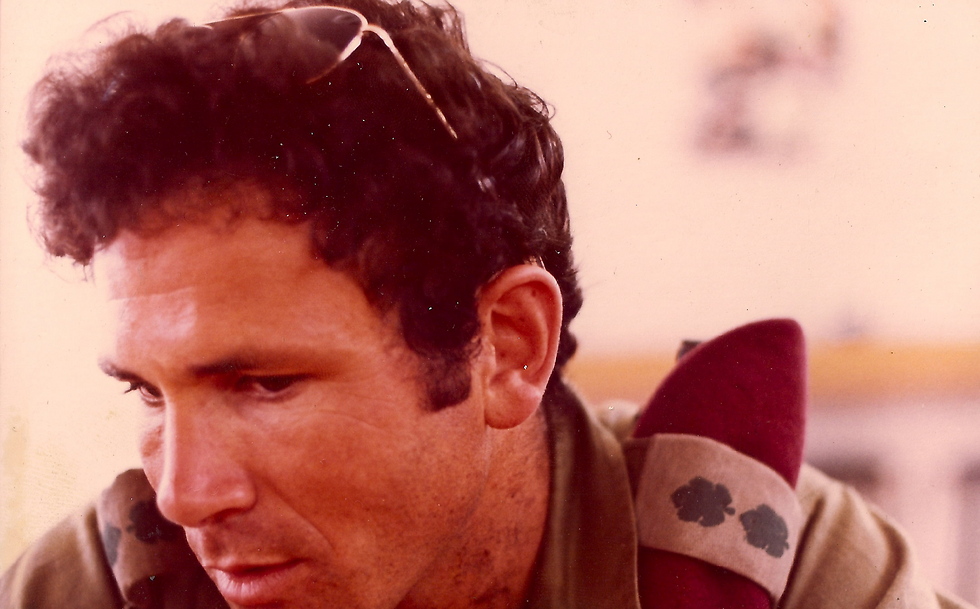
"At this point, Shaul Mofaz and his force had already landed, and I told all teams on the comms: 'Yoni is hurt, I'm taking command, roger that?' They all confirmed. At that moment, I realized: I was no longer responsible just for the raiding force, I was now in command of all of the unit's forces."
Shaul Mofaz, who went on to become the IDF's chief of staff and later the minister of defense, recounts how Yoni had insisted to charge ahead with his soldiers. "When I realized Yoni decided to be part of the raid force, I told him he should be where he can have a full picture of the battlefield, so he could better command the operation. Yoni explained that he had to be part of the raid force. This was my last conversation with Yoni," he says.
"I felt the mission carried a heavier burden on Yoni than any other mission. As for the fact he chose to be with the raid force, where he was hit—in my opinion, he wanted to prove to everyone that he was the commander, that his bravery did not diminish and that under the circumstances he had no other option. He also felt like he alone could convey the messages that ‘we can do this mission.’"
Pinchas Buchris and Dr. David Hassin, now the head of internal medicine at Ichilov Hospital and at the time a combat doctor in Netanyahu's team, were the first to reach the wounded commander.
"We moved towards the entrance of the big hall," says Buchris. "We saw a figure lying on the ground, face-down. We walked up to it, Dr. Hassin and me. When we turned the figure over, we saw it was Yoni Netanyahu. Hassin immediately started treatment. At the same time, we came under fire from the old control tower."
"I grabbed Yoni by his webbing (load-bearing straps) and dragged him away from the line of fire," Dr. Hassin says. "He was unconscious and pale, which was indicative of a great loss of blood. I removed his shirt and saw a small entry wound, about one centimeter in size, under his collar bone, and a clear exit wound. When he was on the gurney, Yoni tried to sit up for a fraction of a second. He was then taken to the evacuation plane that was already parked in its planned spot, some 300 meters from the terminal. It was on the plane that the medical team declared Yoni Netanyahu dead."
Rami Sherman, the operations officer who led the backup force, recounts, "I remember when we were riding on the jeep, Yoni mumbled something, but I couldn't understand what he was saying. I remember that at the time, I didn't think these would be his final breaths."
Part 4 of this story tells of the battle raging outside the terminal, where other forces fought off Ugandan soldiers and worked to thwart any reinforcement from coming.
Dr. Ronen Bergman is Yedioth Ahronoth's chief military and intelligence correspondent. Follow him on Twitter @ronenbergman
Lior Ben-Ami is the head of Yedioth Ahronoth's investigative team. Contact him at lior-ba@yedioth.co.il
















